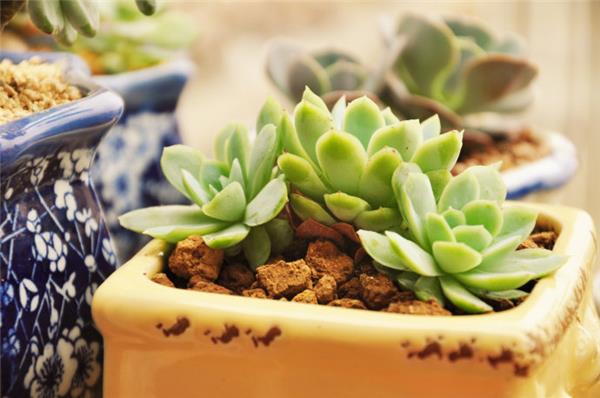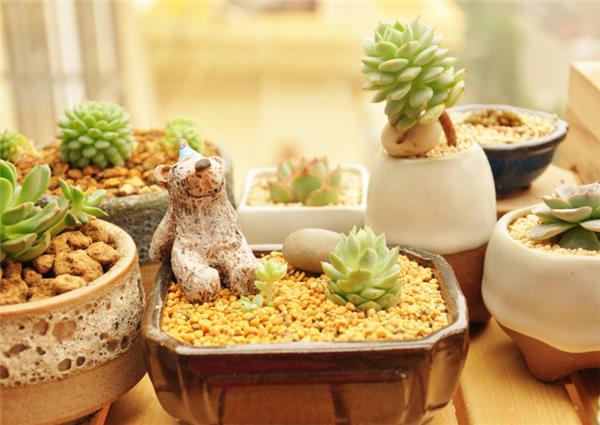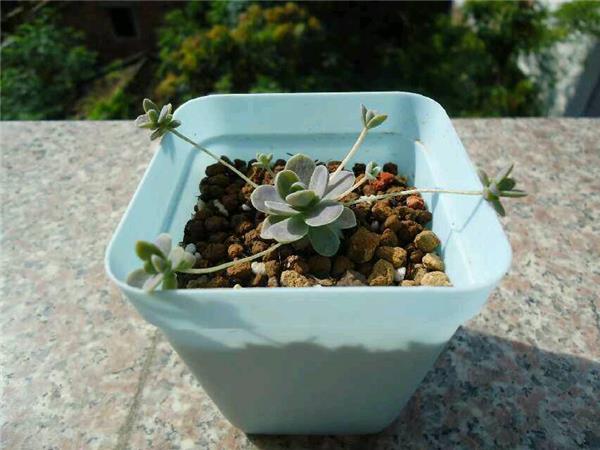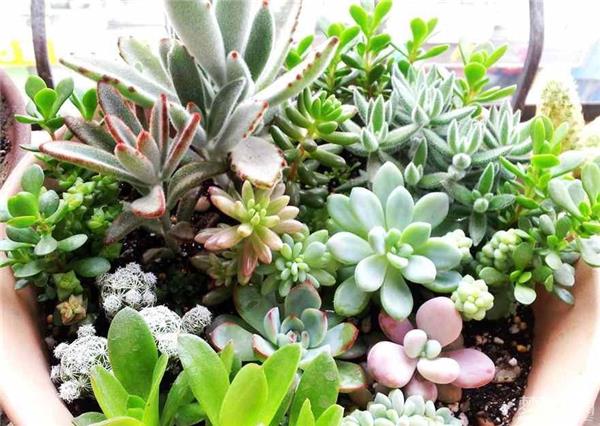[succulent plants change pots] matters needing attention in changing pots and upper pots of succulent plants
Most succulent plants are short and are very suitable to be placed on the table and other positions to relieve visual fatigue and regulate tension.

I. the mode of reproduction of succulent plants
Sowing: the seeds of general succulent plants are stored at room temperature for one year, and the germination rate decreases quickly. For this reason, many succulent plants are picked and sown after the seeds are ripe or stored for spring sowing in the following year. The sowing and germination time of different families and genera is also different, the early 2 days can germinate, the late 25 days will germinate.
Leaf cuttings: thick leaves are often placed on slightly moist sand beds or loose soil, which will soon take root and produce adventitious buds on the base of the leaves, forming plantlets.
Stem cutting: in the process of reproduction of succulent plants, combined with pruning and shaping, cutting branches as cuttings.
Root cuttings: the roots of the more valuable varieties of the 12-volume genus of Liliaceae are very sturdy and developed. The more mature fleshy roots are cut off and buried in the sand bed, and the upper part is slightly exposed to maintain a certain amount of moisture and bright light. New buds can sprout from the top of the root to form a complete plantlet.
Grafting: in succulent plants, grafting is often used to breed varieties of brocade and ornamental plants. However, in the process of grafting, because the plant contains white emulsion, it is sticky. As a result, the grafting operation should strive to be fast and skilled in order to achieve success.
Ramet: ramet is the easiest and safest way to breed succulent plants, which can be carried out when changing pots in spring.

2. the method of potting succulent plants.
Change the soil: whether it is bought from the flower market, greenhouse or online shopping, throw away the soil in the original pot. Because some soil may contain germs or eggs, and some may even contain worms from time to time.
Root washing: you can shake the root back and forth in a basin of water. Do not turn on the big faucet and wash it with very strong water, so that the roots will break a lot. This repeated shaking and soaking several times, you can see the white main root on it. Make sure that basically all the soil carried on the roots is washed away. Because it probably contains a lot of eggs and bacteria.
Trim the roots: cut off the disease roots and dead roots that are black and even have only empty shells. And properly trim off those overgrown, a large number of entangled lateral roots to promote the growth of new fibrous roots. After root pruning treatment, the new root system will be strengthened, so that the plant growth will be stronger. You don't have to fix it if you feel unsure.
Root soaking and sterilization: the root system will definitely be damaged when you trim the root, and then you need to soak in the prepared germicidal solvent for about an hour. Carbendazim, chlorothalonil and methyl topiramate are all available. Do not adjust the concentration too high, you can soak multiple plants in a small washbasin.
Root drying: if you are afraid of root decay, water it after a few days and leave it for a week or two. don't let the sun dehydrate during this period. Weak sunlight can make the plant return to its natural state more quickly and leave it under the sun for normal maintenance after survival.

3. How to change pots for succulent plants
Generally, succulent plants change their pots every 1 to 3 years. Most varieties generally change pots from mid-March to early April, while some winter-type species that grow in winter and dormancy in summer can also change pots from the end of August to early September. In short, the time to change the pot should be carried out when the dormant period is coming to an end and the plant is about to grow. Tufted plants can also be propagated at the same time when changing pots. In addition, if it is found that the plant has rotten roots, you can change the pot at any time.
Stop watering 3 to 5 days before changing the basin. When changing the basin, first deduct the plant from the basin and shake the soil at the root clean. Cut off the old root, rotten root and hollow root, and retain the root system with strong, full and good absorptive capacity. However, for varieties with hypertrophic fleshy roots, such as cactus, peony and black jade, it is not easy to excessively cut roots, because these fleshy roots store rich nutrients, if excessive pruning will affect growth, even rotten roots, and the whole plant will die. If there are young plants next to the old plants, you can break them off, prune the roots properly, remove the dry leaves, and plant them separately. If the wound is too large when dividing the plant, you can apply sulfur powder, charcoal powder, carbendazim or other antiseptic drugs to the wound and let it dry for 3 to 7 days.

The stems and leaves of succulent plants are mostly fat and fat, very cute, and have a good ornamental effect, so in the daily maintenance, we must take care of them carefully and take good care of them.
The stems and leaves of succulent plants are mostly fat and fat, very cute, and have a good ornamental effect, so in the daily maintenance, we must take care of them carefully and take good care of them.
Related
- Wuhan Hospital Iron Tree Blooming Result Was Instantly Frightened by the Gardener Master
- Which variety of camellia is the most fragrant and best? Which one do you like best?
- What is the small blue coat, the breeding methods and matters needing attention of the succulent plant
- Dormancy time and maintenance management of succulent plants during dormancy
- Minas succulent how to raise, Minas succulent plant pictures
- What are the varieties of winter succulent plants
- How to raise succulent plants in twelve rolls? let's take a look at some experience of breeding twelve rolls.
- Attention should be paid to water control for succulent plants during dormant period (winter and summer)
- Watering experience of twelve rolls of succulent plants
- Techniques for fertilizing succulent plants. An article will let you know how to fertilize succulent plants.



